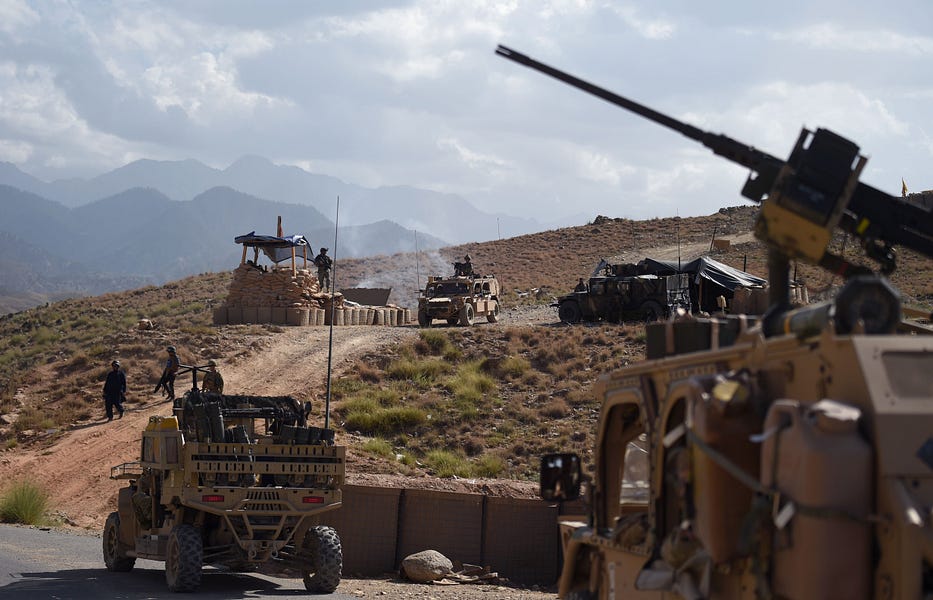This week: recent developments in the original 9/11 conflict, the war in Afghanistan. News reports suggest that the Trump administration is close to signing some kind of deal with the Taliban. But it’s not a peace accord. The emerging details of the deal—and the preemptive concessions the U.S. is apparently willing to make for the Taliban to agree to it—suggest that the deal is less about securing a lasting peace and more about political and diplomatic cover in anticipation of an exit decided on long ago. First, some background.
A comment on the “endless wars.”
The U.S. government wants to pivot away from the 9/11 wars and, for the most part, already has, as I explored in the first issue of Vital Interests. The days of large-scale American war efforts to combat the jihadists are over. But the jihadists haven’t been defeated, so the U.S. maintains a presence in several countries to fight them. According to published reports, there are fewer than 20,000 American servicemembers in Afghanistan, Iraq, and Syria, with several thousand more stationed across Africa. These figures are just ballpark estimates and don’t include the thousands of contractors who are also working in various jihadist hotspots.
President Trump and his Democratic challengers want to further reduce that footprint, decrying these “endless wars.” I’ve spoken with senior Trump administration officials about these matters on multiple occasions since 2017, including just recently. Two officials reiterated to me earlier this month that President Trump doesn’t want to be stuck with the Afghan war heading into the 2020 presidential election. He doesn’t want to be forced to explain why his administration has kept Americans in the country after he vowed to extricate the U.S. from the supposedly unwinnable war. In other words, he has a strong political incentive to show Americans that he is “ending” their country’s role in the war by withdrawing most, if not all, of the remaining forces. The president is, of course, an erratic decision-maker, so there are no guarantees. But he has repeatedly expressed his desire to just get out on multiple occasions.
Quite frankly, I think some of President Trump’s criticisms are well-placed, even if I don’t always agree with the manner in which he conveys them. I’ll get into this more in future editions of Vital Interests, but the bottom line for me is that the U.S. military and intelligence establishment has offered wildly inaccurate assessments of the conflict for years. In addition to wasteful spending, U.S. military leaders often relayed a rose-colored view of the war—one that didn’t comport with the facts on the ground.
The context for the current situation is important: America already had a president who decided to withdraw from Afghanistan, and then didn’t.
President Barack Obama ordered a short-lived surge of forces into Afghanistan. That effort was brought to an end in 2011 and 2012. In 2014, Obama declared America’s combat mission over and announced his intention to withdraw entirely by the end of 2016, that is, at the conclusion of his presidency. By early 2015, the U.S. had drawn down to fewer than 10,000 servicemembers.
So, Obama didn’t bring a “responsible end” to the Afghan war as he said he would. He and his advisers repeatedly used that phrase—“responsible end”—when discussing the wars in Afghanistan and Iraq. Obama said he had delivered on this promise with respect to Iraq, but of course that didn’t go so well. The withdrawal of American forces from Saddam Hussein’s former Stalinist playground helped pave the way for the rise of ISIS, forcing Obama himself to recommit a smaller number of forces to both Iraq and Syria. That may very well have influenced his reversal with respect to Afghanistan. Although Obama wanted to leave that war behind, he decided to keep a smaller presence in place because the Taliban was rising, threatening to topple the Afghan government.
All of which is to say, when you hear the politicians and pundits talking about “endless wars” in 2020, just remember we’ve been having this conversation for years. President Obama tried to “end” America’s role in the 9/11 wars and he drew down to a point that is awfully close to the U.S. military’s current footprint. He didn’t fulfill his pledge for a simple reason: The enemy gets a vote.
Too often, the current discussion over Afghanistan is framed as a simple debate between those who want to leave Afghanistan and those who want to stay. That is entirely dishonest. Very few of those involved in these debates want the U.S. troops to remain in Afghanistan, in a combat role, indefinitely. The question is—or ought to be—how to leave without re-creating the conditions that led to our intervention in the first place.
Trump inherited a war with one American foot already out the door.
In 2017, President Trump inherited a dire situation in Afghanistan. Against his stated preference at the time, Trump decided to send several thousand more troops to Afghanistan. This wasn’t a huge surge of forces. There are roughly 12,000 American servicemembers still there. Along with their NATO allies and contractors, they are serving two principal missions: 1) training and advising the Afghan forces and 2) conducting counterterrorism missions against high-profile targets.
Three years after Trump took office, the main problem is that the Afghans, who are carrying out the bulk of the fighting, aren’t close to being self-sufficient. More to the point: They probably never will be. It’s an untenable situation. The Taliban and its jihadist allies, namely al-Qaeda, are controlling or contesting more ground than at any point since 2001. Most of this is sparsely populated rural terrain, but they are prepared to pounce on several provincial capitals in the near future.
No ceasefire.
The Trump administration sees a deal with the Taliban as a viable way out. But the proposed deal isn’t a peace accord. It appears that a first, temporary deal calls for a “reduction in violence” (RIV) over a period of seven days or so, after which the two sides intend to sign a longer and more consequential agreement. We don’t know exactly what’s in the short-term “RIV” deal, or the longer accord, as the two sides haven’t made the terms available to the public. That’s both suspicious and problematic.
First, it’s a problem that the parties are calling for an amorphous “reduction in violence,” and not a true ceasefire. There’s a simple explanation: The Taliban wouldn’t agree to a ceasefire. U.S. Special Representative Zalmay Khalilzad, who is leading the talks with the Taliban, has said that a “comprehensive ceasefire” is necessary for peace. He hasn’t delivered anything close to that. So, the State Department came up with creative language to make it seem like the jihadists have made some sort of significant concession.
But the Taliban isn’t in the concession business, the State Department is. The talks have taken place entirely on the Taliban’s terms. The Taliban demanded that the Afghan government be excluded from the negotiations, and the U.S. quickly acquiesced in 2018. This means that the internationally recognized government, which American taxpayers have spent billions of dollars to stand up, wasn’t even granted a formal seat at the table in Doha, where the agreements were hashed out.
The Afghan government can only hope to participate in “intra-Afghan” talks (another amorphous term) after the U.S. has consummated its own bilateral deal with the Taliban. Of course, there is no guarantee those talks will be fruitful.
The Taliban seeks to resurrect its Islamic Emirate.
The Taliban has steadfastly refused to recognize the Afghan government’s legitimacy. Instead, the Taliban consistently says it is fighting to resurrect its own “Islamic Emirate of Afghanistan” (IEA)—the same totalitarian regime the U.S. and its allies toppled in 2001. The Taliban-led insurgency has been acquiring rural territory and contesting security forces ever since then, but the insurgency is stronger today than ever, meaning the jihadists are positioning themselves to overthrow the Afghan government.
Taliban apologists and other advocates of the proposed U.S.-Taliban deal pretend that this isn’t the case. They want us to believe there is a realistic chance the Taliban will come to terms with other parties and form a new government that isn’t merely a resurrection of its authoritarian emirate. There is no good reason to think that this is true. The Taliban regularly reminds us that the restoration of its “Islamic Emirate of Afghanistan” is its central goal.
On February 11, for example, the Taliban released a lengthy victory video, declaring the U.S. a spent force and crowing about its accomplishments. The production opened with a clip of President Trump saying, “The American people are weary of war, without victory.” This is no doubt true for a fair number of Americans, and it gives the Taliban obvious leverage. The Taliban is not similarly burdened with popular doubts and sees its victory not in some glorious defeat of U.S. forces on the battlefield but, more simply, in a U.S. withdrawal.
The Taliban took the time to explain to viewers why its “Islamic Emirate” finds itself “in such a successful state against [the] U.S., her allies and their puppets”—namely, the Afghan government. The Taliban’s propagandists bragged that they had developed some “notable” policies that could “benefit … other Islamic movements” around the globe. Although some Western commentators portray the group as purely nationalistic, the Taliban explained to its audience why its war is part of the broader global jihad.
The video laments the fall of the Ottoman’s Islamic Caliphate in the 1920s, arguing that since that time “the Muslims have been victims of division,” and “distance[d] from the Islamic Sharia [law].” In other words, Muslims haven’t been able to live under the type of strict religious laws favored by the Taliban—and al-Qaeda. But Muslims should view the Taliban’s “Islamic Emirate of Afghanistan” as the “most successful … Islamic movement,” a sign that they may “rise again” in communal power. The group called on other “Islamic movements of the world” to follow its “jihadist, political, and military policies,” because in so doing they can avoid divisions, “gain popular support” and direct their efforts to “final victory.”
The Taliban bragged that its Islamic Emirate is becoming “stronger day after day,” as its “authority and influence is increasing.” Tellingly, the video celebrates praised the “powerful attacks” carried out by the “Martyrdom-seeking” brothers against the “Crusader invaders.”
The Taliban video mentioned here isn’t unique. The group puts out this type of messaging—trumpeting the return of its Islamic Emirate—all the time. Advocates of the U.S. deal with the Taliban have to ignore such stark messaging or pretend the Taliban doesn’t really mean it. After reporting on the Taliban for more than 15 years, however, I can’t think of any legitimate reason to think the Taliban doesn’t mean what it says in this regard. The group has tens of thousands of fighters, many of whom are committed to the return of an ISIS-style government. It is difficult, if not impossible, to see how the Taliban’s leadership could sell them something different now. And there is no reason to think the Taliban’s leadership is fighting for something other than their Islamic Emirate. That’s the whole point of their jihad.
By agreeing to a deal with the Taliban before the Afghan government even gets a seat at the table, the State Department gave up whatever little leverage the U.S. has to convince the Taliban that its Islamic Emirate cannot achieve victory. That is, the U.S. has validated the Taliban’s longstanding claim that the government in Kabul is nothing but a “puppet,” which doesn’t really have sovereignty or authority in this war.
Secret annexes?
The State Department is reportedly still trying to sell Americans on the idea that the Taliban will somehow renounce al-Qaeda. I’ve dealt with this issue at length in the past, so I won’t rehash all of the reasons I think this is disingenuous. If you are interested, you can read my congressional testimony from last September. In that testimony, I provided some historical background dating to the mid-1990s, as well as more current evidence. The bottom line: The Taliban has lied about its partnership with al-Qaeda from the beginning, and there is no reason to believe whatever the Taliban’s negotiating team in Doha says now. The Taliban and al-Qaeda remain closely intertwined on the battlefield to this day. (I’ve also written about this topic for Politico and The Dispatch. The latter piece looks at what has transpired since Special Representative Khalilzad first vouched for the Taliban’s supposed counterterrorism assurances in early 2019. Simply put, Khalilzad’s credulity doesn’t inspire confidence.)
There is one recent report I want to address here. According to Time’sKim Dozier, Khalilzad has crafted several “secret annexes,” which is where all of the supposed concessions by the Taliban are made. That’s convenient. My sources say these “secret annexes” likely act like black boxes, which the State Department can use to portray the deal as a decent one, hiding any uncomfortable facts from the public. And of course, the Taliban’s political team may be willing to agree to something in secret in Doha just to get the U.S. out, but that doesn’t mean the Taliban’s warlords in Afghanistan and Pakistan will abide by it.
According to Dozier’s sources, the first annex allows for U.S. counterterrorism forces to stay in the country, while the second contains the Taliban’s “denouncement of terrorism and violent extremism.”
If this is true, it is likely a smokescreen. The Taliban has repeatedly insisted that all American forces be withdrawn from the country. The idea that the Taliban would give its permission for select counterterrorism strikes against anyone other than ISIS (which is opposed to the Taliban and al-Qaeda) is preposterous. In September, for instance, a joint U.S.-Afghan team killed one of al-Qaeda’s top leaders—in a Taliban stronghold in Musa Qala, Helmand. That figure, Asim Umar, died alongside his Taliban compatriots. The Taliban’s leaders didn’t tell the Americans that Umar was enjoying their protection, and they lied about his presence there after the fact. There is no reason to think the Taliban is going to give up other al-Qaeda leaders or fighters either.
Moreover, if Khalilzad really intends to use secret annexes, then the State Department has moved the goalposts. In September of last year, Secretary of State Mike Pompeo said the Taliban would “break from al-Qaeda publicly and permanently.” If Dozier’s account is right, the Taliban will now only renounce al-Qaeda, or terrorism more generally, in secret.
I get why people are sick of talking about Afghanistan and why there is widespread political pressure to just get out. But whitewashing the Taliban on the way out the door is an especially ignoble way to “end” America’s role in the war.
Photograph of U.S. and Afghan forces in Afghanistan by Wakil Kohsar/AFP/Getty Images.







Please note that we at The Dispatch hold ourselves, our work, and our commenters to a higher standard than other places on the internet. We welcome comments that foster genuine debate or discussion—including comments critical of us or our work—but responses that include ad hominem attacks on fellow Dispatch members or are intended to stoke fear and anger may be moderated.